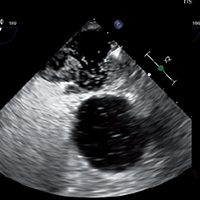Platypnea orthodeoxia syndrome in a patient with patent foramen ovale and normal atrial pressure. Case report and presentation of underlying pathophysiological mechanisms

Submitted: April 5, 2021
Accepted: June 13, 2021
Published: September 28, 2021
Accepted: June 13, 2021
Abstract Views: 1193
PDF: 511
Video 1: 133
Video 2: 153
Video 1: 133
Video 2: 153
Publisher's note
All claims expressed in this article are solely those of the authors and do not necessarily represent those of their affiliated organizations, or those of the publisher, the editors and the reviewers. Any product that may be evaluated in this article or claim that may be made by its manufacturer is not guaranteed or endorsed by the publisher.
All claims expressed in this article are solely those of the authors and do not necessarily represent those of their affiliated organizations, or those of the publisher, the editors and the reviewers. Any product that may be evaluated in this article or claim that may be made by its manufacturer is not guaranteed or endorsed by the publisher.
Similar Articles
- Vasiliki Epameinondas Georgakopoulou, Dimitrios Mermigkis, Despoina Melemeni, Aikaterini Gkoufa, Christos Damaskos, Nikolaos Garmpis, Anna Garmpi, Nikolaos Trakas, Xanthi Tsiafaki, Cytomegalovirus pneumonia in an immunocompetent host with primary ciliary dyskinesia: A case report , Monaldi Archives for Chest Disease: Vol. 91 No. 3 (2021)
- Mehul Agarwal, Manohar Lal Gupta, Kunal Deokar, Benhur Joel Shadrach, Neha Bharti, Maldev Sonigra, Clinico-radiological profile of connective tissue disease related-interstitial lung diseases from a tertiary care centre of India: a cross sectional study , Monaldi Archives for Chest Disease: Vol. 91 No. 4 (2021)
- Amos Lal, Ajay Kumar Mishra, Jamal Akhtar, Christoph Nabzdyk, Pneumothorax and pneumomediastinum in COVID-19 acute respiratory distress syndrome , Monaldi Archives for Chest Disease: Vol. 91 No. 2 (2021)
- Parul Mrigpuri, Sonal Sonal, Sonam Spalgais, Nitin Goel, Balakrishnan Menon, Raj Kumar, Uncontrolled diabetes mellitus: A risk factor for post COVID fibrosis , Monaldi Archives for Chest Disease: Vol. 91 No. 1 (2021)
- Vaishali Verma, Sachin Sondhi, Rajesh Sharma, Kunal Mahajan, COVID-19 associated viral myocarditis: does it exist? , Monaldi Archives for Chest Disease: Vol. 90 No. 4 (2020)
- Sunil Mahavar, Princy Tyagi, Abhishek Agrawal, Sudhir Bhandari, Subrata Banerjee, Raman Sharma, Prakash Keshwani, Clinical and epidemiological profile of Indian COVID-19 patients from Jaipur: a descriptive study , Monaldi Archives for Chest Disease: Vol. 91 No. 2 (2021)
- Gaia Cipolla, Rosalba Relo, Elisa Pasciuta, Domenica Catalano, Federica Lo Bello, Irene Coppolino, Paolo Ruggeri, Alfio Proietto, Maria Buccafusca, Paola Maria Cutroneo, Gianluca Trifirò, Gaetano Caramori, A case of lung injury resembling diffuse pulmonary hemorrhage after the first administration of alemtuzumab in a patient with multiple sclerosis. Role of the HRCT , Monaldi Archives for Chest Disease: Vol. 90 No. 3 (2020)
- Despoina Moumtzi, Marianna Kakoura, Pulmonary embolism in Behcet's disease: a case report , Monaldi Archives for Chest Disease: Vol. 90 No. 4 (2020)
- Shekhar Kunal, Kashish Gupta, Shashi Mohan Sharma, Vijay Pathak, Shruti Mittal, Chandrakant Tarke, Cardiovascular system and COVID-19: perspectives from a developing country , Monaldi Archives for Chest Disease: Vol. 90 No. 2 (2020)
- Kamal Kant Sahu, Ajay Kumar Mishra, Amos Lal, COVID-2019: update on epidemiology, disease spread and management , Monaldi Archives for Chest Disease: Vol. 90 No. 1 (2020)
<< < 12 13 14 15 16 17 18 19 20 > >>
You may also start an advanced similarity search for this article.

 https://doi.org/10.4081/monaldi.2021.1878
https://doi.org/10.4081/monaldi.2021.1878





